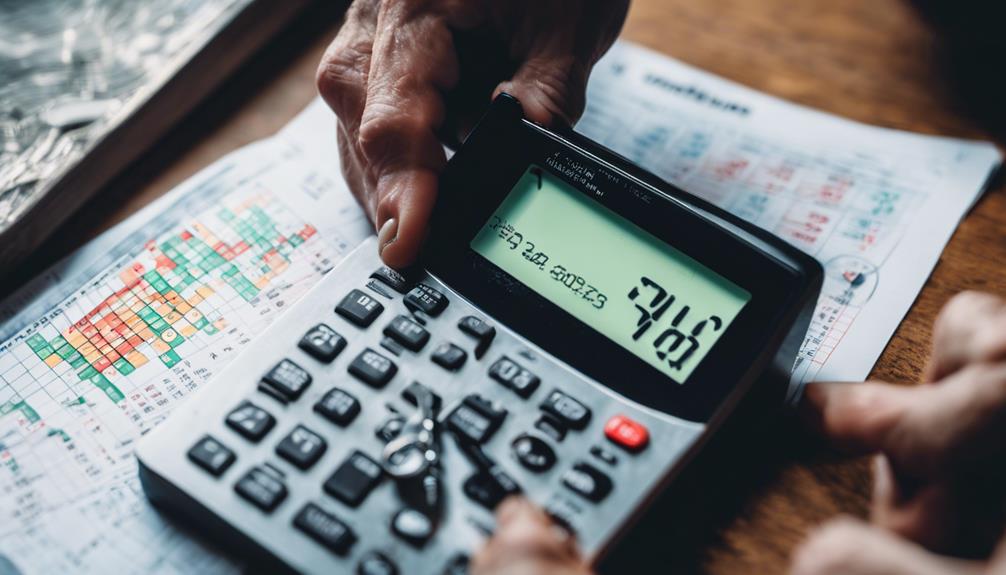When evaluating a Bitcoin IRA, it is crucial to weigh the costs against the benefits. Bitcoin IRAs can provide tax advantages, portfolio diversification, and potential for growth, but they also come with high account fees and volatility risks. It is important to understand your risk tolerance and investment goals to determine if the fees are justified. Assessing fee structures, setup, maintenance, transactions, and holdings is essential to gauge their impact on long-term savings. Considering long-term financial implications, security concerns, and investment performance can help you make an informed decision. Thoroughly analyzing the cost-benefit ratio is key when it comes to Bitcoin IRAs.
Key Takeaways
- Consider tax advantages and potential growth against high fees.
- Evaluate diversification benefits and security provided by Bitcoin IRAs.
- Assess risk tolerance, investment goals, and long-term financial objectives.
- Analyze fees impact on returns and retirement savings.
- Understand fee structure to optimize savings and investment outcomes.
Cost-Benefit Analysis of Bitcoin IRAs

When evaluating the cost-benefit analysis of Bitcoin IRAs, investors must carefully consider the potential advantages of exposure to cryptocurrencies within a tax-advantaged account against the accompanying fees. Bitcoin IRAs typically come with high fees, including monthly account fees, transaction fees, and holding fees. These costs can vary among different providers and greatly impact the overall returns of the investment.
Investors interested in Bitcoin IRAs need to weigh these fees against the potential benefits of having exposure to cryptocurrencies within a retirement account. The cost-benefit ratio of a Bitcoin IRA is influenced by factors such as the investor's risk tolerance, long-term investment goals, and understanding of cryptocurrency volatility. While the fees may seem substantial, the potential for significant growth in the cryptocurrency market could potentially outweigh these costs for some investors.
It is essential for investors to conduct a thorough analysis comparing the fees with the potential gains to determine if a Bitcoin IRA aligns with their financial objectives.
Advantages of Bitcoin IRAs

Bitcoin IRAs offer investors a unique opportunity to access tax advantages similar to traditional IRAs while providing exposure to digital assets like Bitcoin. These IRAs allow for tax-free growth, potentially saving on capital gains taxes.
By investing in digital assets through Bitcoin IRAs, individuals can diversify their retirement portfolios beyond traditional stocks and bonds, gaining exposure to a growing asset class. This diversification can act as a hedge against inflation, safeguarding savings against the devaluation of fiat currencies.
Additionally, Bitcoin IRAs simplify security concerns by offering custodial services, ensuring a secure way to hold and manage digital assets for retirement savings. As Bitcoin and cryptocurrencies gain popularity and acceptance in the financial industry, investors in Bitcoin IRAs have the potential for long-term growth, making them a compelling option for those looking to explore alternative investments within their retirement accounts.
Potential Growth in Cryptocurrency Investments

The potential growth in cryptocurrency investments is a topic of great interest, as the market has shown remarkable expansion in recent years. Factors such as increasing institutional adoption, regulatory developments, and technological advancements contribute to the positive outlook for cryptocurrency investments.
Despite the opportunities for growth, it is imperative for investors to ponder the associated risks and rewards, as the market is known for its volatility.
Cryptocurrency Investment Growth
Amidst a landscape of exponential growth in digital assets, the expansion of cryptocurrency investments stands as evidence of the increasing allure of decentralized finance. Cryptocurrency investments have seen significant growth, with Bitcoin's value skyrocketing from around $1,000 in 2017 to over $60,000 in 2021. The total market capitalization of cryptocurrencies has surpassed $2 trillion, showcasing the rising interest and investment in digital assets.
Prominent institutional investors such as Tesla, MicroStrategy, and Square have allocated billions of dollars to Bitcoin, indicating mainstream acceptance and potential growth in the crypto market. This growth is fueled by factors like increased adoption, limited supply, decentralized nature, and the growing acceptance of cryptocurrencies as a store of value. Analysts project further growth in cryptocurrency investments due to expanding use cases, advancements in blockchain technology, and macroeconomic uncertainties.
Risks and Rewards
Significant price fluctuations in the cryptocurrency market present both risks and potential rewards for investors considering digital assets within their IRA portfolios.
While investing in a Bitcoin IRA offers the opportunity for high growth, it also comes with inherent risks. The volatile nature of cryptocurrencies can lead to substantial returns, but it also exposes investors to the possibility of significant losses.
Despite the uncertainties, the long-term growth potential of digital assets such as Bitcoin may be attractive to those looking for high-growth opportunities within their retirement accounts.
Evaluating the cost-benefit ratio of a Bitcoin IRA should involve weighing the potential rewards regarding growth and diversification against the associated risks and fees, ensuring a balanced approach to retirement investment planning.
Market Volatility Analysis
Examining the dynamic nature of market volatility in cryptocurrencies sheds light on the potential growth opportunities for investors considering digital assets like Bitcoin within their portfolios. Despite fluctuations, Bitcoin has shown remarkable long-term growth, with its price surging from $900 in 2016 to over $60,000 in 2021.
The historical data indicates that cryptocurrencies, particularly Bitcoin, have the potential for substantial long-term growth, making them attractive to investors seeking high returns. With Bitcoin's market dominance exceeding $1 trillion and gaining mainstream acceptance, the market volatility presents opportunities for investors to leverage price swings and maximize returns in a Bitcoin IRA.
Institutional adoption of cryptocurrencies further signals confidence in the enduring value and growth potential of digital assets, making Bitcoin IRAs a compelling option for long-term investment strategies.
Disadvantages of Bitcoin IRAs

When contemplating Bitcoin IRAs, investors must carefully weigh the drawbacks associated with investing in cryptocurrencies for retirement. One prominent disadvantage is the high account fees that come with Bitcoin IRAs, which can greatly impact the overall returns on investment. These high fees include account maintenance fees, trading fees, and custody fees, making it essential for investors to assess the cost-effectiveness of these accounts.
Additionally, the volatile nature of Bitcoin and other digital assets held in IRAs poses a risk of substantial losses. The price swings in the cryptocurrency market can lead to notable declines in the value of the retirement portfolio, highlighting the need for cautious decision-making.
Furthermore, the unique security and custody requirements for Bitcoin IRAs can result in increased fees compared to traditional retirement accounts, adding another layer of complexity and cost for investors to take into account when planning for their retirement.
Considerations for Account Fees

Considering the financial implications of Bitcoin IRAs, understanding and evaluating the account fees associated with these investment vehicles is essential for informed decision-making.
When analyzing account fees for a Bitcoin IRA, investors should consider the following:
- Setup Fees: Bitcoin IRAs may entail one-time setup fees, which can vary among providers.
- Maintenance Fees: Monthly maintenance fees might apply to keep the account active and managed by the custodian.
- Transaction Fees: Custodians often charge transaction fees for buying and selling cryptocurrencies within the account.
- Holding Fees: Some custodians may impose holding fees based on the total value of assets held in the Bitcoin IRA.
Careful review of the fee structure is vital to understand the impact on long-term returns and retirement savings. While higher fees may deter some investors, it is crucial to weigh these costs against potential benefits such as tax advantages and portfolio diversification to determine the overall cost-benefit ratio of a Bitcoin IRA.
Risks Associated With Bitcoin IRAS

Bitcoin IRAs pose significant risks due to the high fees involved, security vulnerabilities related to private and public keys, and the need for experienced custodians to guarantee asset management and protection.
While these retirement accounts offer tax advantages, investors should be aware of the potential drawbacks. High fees, including monthly account fees and holding fees, can eat into profits and impact long-term savings goals.
Security risks stemming from the management of private and public keys can expose investors to the possibility of theft or loss of their digital assets. Hence, having experienced custodians overseeing Bitcoin IRAs is essential to mitigate these risks and ensure proper asset protection.
While tax advantages are appealing, individuals must weigh them against the security and fee considerations to make informed decisions about incorporating Bitcoin IRAs into their retirement portfolios. Insurance coverage is also essential to safeguard against unforeseen risks and potential losses in the volatile cryptocurrency market.
Evaluating Long-Term Financial Goals

When considering a Bitcoin IRA as part of your long-term financial goals, it is essential to establish clear objectives that align with your retirement plans.
Understanding your risk tolerance and reviewing the investment performance of digital assets can help you make informed decisions regarding your financial future.
Setting Clear Objectives
Establishing precise financial objectives is essential when evaluating long-term goals for a Bitcoin IRA. When setting clear objectives, take into account factors such as risk tolerance, investment horizon, and desired returns.
To evaluate the cost-benefit ratio of a Bitcoin IRA effectively, it is vital to define your objectives clearly. Here are key points to keep in mind:
- Identify your long-term financial goals, whether they involve retirement savings, wealth preservation, or portfolio diversification.
- Determine your risk tolerance level to assess how comfortable you are with potential fluctuations in the value of your investment.
- Define your investment horizon, outlining the duration for which you intend to hold your Bitcoin IRA.
- Establish your desired returns to align your investment objectives with your financial aspirations.
Clear objectives will help you make informed decisions regarding the suitability of a Bitcoin IRA for your specific needs.
Considering Risk Tolerance
Evaluating one's risk tolerance is an essential factor in gauging long-term financial goals, especially when contemplating investments like a Bitcoin IRA due to the inherent volatility in cryptocurrencies.
Understanding how much risk one can comfortably handle is vital when deciding if a Bitcoin IRA aligns with long-term financial objectives. Investors must assess whether they are prepared for potential market fluctuations and losses associated with cryptocurrencies.
It is essential that the level of risk tolerance matches the chosen long-term investment strategy to justify the fees linked to a Bitcoin IRA. Factors such as retirement timeline, financial stability, and the need for portfolio diversification should all be considered when determining the suitability of a Bitcoin IRA based on individual circumstances.
Reviewing Investment Performance
To evaluate the alignment of a Bitcoin IRA with long-term financial goals, it is essential to review the investment performance by comparing historical returns against traditional options like stocks and bonds. When appraising the investment performance of a Bitcoin IRA, consider factors such as:
- Historical Returns: Analyze the past performance of Bitcoin and cryptocurrencies within IRA accounts to gauge potential growth.
- Risk vs. Return: Evaluate the level of risk associated with Bitcoin IRA investments compared to traditional assets like stocks and bonds.
- Portfolio Diversification: Assess how a Bitcoin IRA can contribute to diversifying a retirement portfolio to mitigate risk.
- Long-Term Financial Goals: Determine if the investment performance of a Bitcoin IRA aligns with your objectives for retirement savings growth.
Making Informed Investment Decisions

Investors seeking to maximize their retirement savings must carefully assess the fees associated with Bitcoin IRAs to make well-informed investment decisions. High fees such as monthly account fees, transaction fees, and holding fees can have a substantial impact on retirement savings and investment returns.
The cost-benefit ratio of a Bitcoin IRA depends on various factors, including account fees, potential returns, and individual risk tolerance. Understanding these fees is vital for making informed decisions regarding investment choices.
Evaluating the long-term benefits and growth potential of Bitcoin investments can help investors determine whether the associated fees are worth it. By conducting a thorough analysis of the fees involved and comparing them to the expected returns, individuals can make informed choices that align with their retirement goals.
Being aware of the fee structure of Bitcoin IRAs empowers investors to make strategic decisions that optimize their savings and investment outcomes in the long run.
Frequently Asked Questions
Is It a Good Idea to Have a Bitcoin Ira?
Investing in a Bitcoin IRA can be a strategic move for those seeking exposure to digital assets within a tax-advantaged retirement account. This option allows for diversification by including cryptocurrencies in one's portfolio.
However, the decision requires careful consideration of factors such as risk tolerance, retirement goals, and associated fees. Understanding the potential benefits and risks of a Bitcoin IRA is essential before making a decision on whether it aligns with one's financial objectives.
What Is the Fee Structure of the Bitcoin Ira?
The fee structure of a Bitcoin IRA typically encompasses one-time setup fees, transaction fees, and security fees. These fees cover services such as custodian support for compliance and security measures. Costs for Bitcoin IRAs may vary depending on the custodian and services offered.
Designed to manage accounts, guarantee security, and maintain compliance, the fee structure aims to provide a thorough investment solution. Investors should assess this structure carefully to determine the value proposition before committing funds.
What Is the Minimum Investment for a Bitcoin Ira?
The minimum investment for a Bitcoin IRA typically ranges from $3,000 to $5,000, with some providers having no minimum balance requirement. Higher minimum investments may be necessary for specific alternative cryptocurrencies within the IRA. Investors should carefully consider this amount alongside fees and potential returns.
A lower minimum investment may be attractive to those seeking to start with a smaller initial sum in a Bitcoin IRA, offering flexibility in entry levels for interested individuals.
Is Itrustcapital Fdic Insured?
iTrustCapital, as a platform facilitating cryptocurrency investments within IRAs, is not FDIC insured. This is due to the nature of cryptocurrencies like Bitcoin, which are digital and decentralized, falling outside the scope of FDIC protection traditionally applied to bank accounts.
Investors should be aware of this lack of insurance coverage when considering the risks associated with holding digital assets in IRAs through iTrustCapital.
What is the Cost-Benefit Ratio of a Bitcoin IRA and are the Fees Worth it?
When navigating Bitcoin IRA costs, it’s important to consider the potential benefits. While fees can eat into your returns, the potential for substantial gains in a Bitcoin IRA could outweigh the costs. It’s essential to weigh the cost-benefit ratio and consider your long-term investment goals before making a decision.
Conclusion
To sum up, when evaluating whether a Bitcoin IRA is worth the fees, it is crucial to conduct a comprehensive cost-benefit analysis, consider the pros and cons, and carefully assess long-term financial goals.
As the saying goes, 'Don't put all your eggs in one basket.' Diversification is key in investment decisions to minimize risks and maximize potential growth opportunities.
Making informed choices based on a clear understanding of Bitcoin IRAs can lead to a more secure retirement savings strategy.










